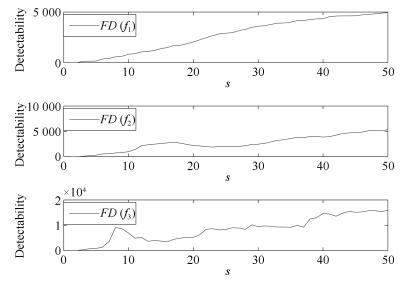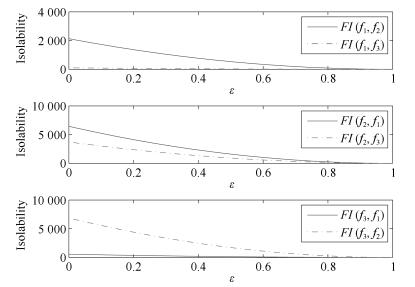-
摘要: 针对缺乏有效的非完全失效故障(Loss of effect,LOE)可诊断性量化分析方法的现状,本文提出了一种基于距离相似度的系统非完全失效故障的实际可诊断性评价方法.通过将状态空间描述的动态系统转换为时间堆栈动态模型,使故障的可诊断性评估分析问题转化为多元分布的相似度问题.给出系统非完全失效故障可检测性与可隔离性的相关定义,并对故障的可诊断性进行量化.通过求取最小二乘解计算最小巴氏距离,增大了算法适用范围.最后,通过仿真实例验证评价方法的有效性,并通过所提出的可诊断性评估算法求取非完全失效故障的最大可诊断效能系数.Abstract: Due to the lack of efficient approaches to quantify actual loss of effect (LOE) fault diagnosability in dynamic systems, a novel presented is presented in this paper. Discrete-time state space models are modified into dynamic models with time window of certain length, and the similarity of different multivariate distributions, instead of fault diagnosability evaluation, is analyzed. The definitions of detectability and isolability of LOE fault are given. Diagnosability performance is quantified by the method based on minimum Bhattacharyya distance. Least-squares method is utilized to enhance applicability of the novel proposed approach. In addition, a simulation example is employed to show the validity of the proposed approach and to analyze maximum effectiveness coefficient of LOE fault in dynamic systems.
-
-
表 1 系统(16)在时间序列$\theta $的输入下的可诊断评价结果($\varepsilon = 0.8$, $s = 5$)
Table 1 Computed distinguishability of dynamic systems (16) with the given fault time profile $\theta $ ($\varepsilon = 0.8$, $s = 5$)
$F{D_\theta }/F{I_\theta }$ ${\rm NF}$ $f_1$ $f_2$ $f_3$ $f_1$ 155.022 0 84.110 3.0614 $f_2$ 274.632 131.22 0 111.20 $f_3$ 830.902 6.7403 126.05 0 表 2 系统(16)在时间序列$\theta $的输入下的可诊断评价结果($s = 3$)
Table 2 Computed distinguishability of dynamic systems (16) with the given fault time profile $\theta $ ($s = 3$)
$F{D_\theta }/F{I_\theta }$ ${\rm NF}$ $f_1$ $f_2$ $f_3$ $f_1$ 130.6592 0 0 0 $f_2$ 61.6940 0 0 0 $f_3$ 346.1748 0 0 0} 表 3 系统(16)在时间序列$\theta $的输入下的可诊断评价结果($s = 6$)~($ \times {10^3}$)
Table 3 Computed distinguishability of dynamic systems (16) with the given fault time profile $\theta $ $(s = 6)~( \times {10^3})$
$F{D_\theta }/F{I_\theta }$ ${\rm NF}$ $f_1$ $f_2$ $f_3$ $f_1$ 0.3585 0 0.0853 0.0040 $f_2$ 0.5403 0.2581 0 0.1489 $f_3$ 1.3274 0.0225 0.2751 0} 表 4 系统(16)在时间序列$\theta $的输入下的可诊断评价结果$(\varepsilon = 0.5)$ $( \times {10^3})$
Table 4 Computed distinguishability of dynamic systems (16) with the given fault time profile $\theta $ $(\varepsilon = 0.5)$ $( \times {10^3})$
$F{D_\theta }/F{I_\theta }$ ${\rm NF}$ $f_1$ $f_2$ $f_3$ $f_1$ 0.9689 0 0.5257 0.0191 $f_2$ 1.7164 0.8202 0 0.6950 $f_3$ 5.1931 0.0421 0.7878 0} 表 5 系统(16)在时间序列$\theta $的输入下的最大可诊断效能系数$({p_i} = 0.3,{p_{i,j}} = 0.4)$
Table 5 Maximum effectiveness coefficient of dynamic systems (16) with the given fault time profile $\theta $ $({p_i} = 0.3,{p_{i,j}} = 0.4)$
$\varepsilon $ ${\rm NF}$ $f_1$ $f_2$ $f_3$ $f_1$ 0.45 0 0.36 0.36 $f_2$ 0.45 0.36 0 0.36 $f_3$ 0.45 0.36 0.36 0 -
[1] Wang Y L, Ma G F, Ding S X, Li C J. Subspace aided data-driven design of robust fault detection and isolation systems. Automatica, 2011, 47(11):2474-2480 doi: 10.1016/j.automatica.2011.05.028 [2] Michail K, Deliparaschos K M, Tzafestas S G, Zolotas A C. AI-based actuator/sensor fault detection with low computational cost for industrial applications. IEEE Transactions on Control Systems Technology, 2016, 24(1):293-301 doi: 10.1109/TCST.2015.2422794 [3] Castillo I, Edgar T F, Dunia R. Nonlinear detection and isolation of multiple faults using residuals modeling. Industrial & Engineering Chemistry Research, 2013, 53(13):5217-5233 [4] Sadeh J, Bakhshizadeh E, Kazemzadeh R. A new fault location algorithm for radial distribution systems using modal analysis. International Journal of Electrical Power & Energy Systems, 2013, 45(1):271-278 [5] Ding S. Model-based Fault Diagnosis Techniques:Design Schemes, Algorithms, and Tools. Berlin Heidelberg:Springer-Verlag, 2008. 69-83 http://d.wanfangdata.com.cn/NSTLQK/NSTL_QKJJ023040606/ [6] Del Gobbo D, Napolitano M R. Issues in fault detectability for dynamic systems. In:Proceedings of the 2000 American Control Conference. Chicago, IL, USA:IEEE, 2000. 3203-3207 [7] Pucel X, Travé-Massuyès L, Pencolé Y. Another point of view on diagnosability. In:Proceedings of the 2008 conference on STAIRS 2008:Proceedings of the Fourth Starting AI Researchers' Symposium. Amsterdam, The Netherlands:IOS Press, 2008. 151-162 [8] Leal R, Aguilar J, Travé-Massuyès L, Camargo E, Rios A. An approach for diagnosability analysis and sensor placement for continuous processes based on evolutionary algorithms and analytical redundancy. Applied Mathematical Sciences, 2015, 9(43):2125-2146 [9] Chi G Y, Wang D W, Zhu S Q. An integrated approach for sensor placement in linear dynamic systems. Journal of the Franklin Institute, 2015, 352(3):1056-1079 doi: 10.1016/j.jfranklin.2014.11.013 [10] Jung D, Khorasgani H, Frisk E, Krysander M, Biswas G. Analysis of fault isolation assumptions when comparing model-based design approaches of diagnosis systems. IFAC-PapersOnLine, 2015, 48(21):1289-1296 doi: 10.1016/j.ifacol.2015.09.703 [11] Nyberg M. Criterions for detectability and strong detectability of faults in linear systems. International Journal of Control, 2002, 75(7):490-501 doi: 10.1080/00207170110121303 [12] Roberts C, Dassanayake H P B, Lehrasab N, Goodman C J. Distributed quantitative and qualitative fault diagnosis:railway junction case study. Control Engineering Practice, 2002, 10(4):419-429 doi: 10.1016/S0967-0661(01)00159-9 [13] Travé-Massuyès L, Escobet T, Olive X. Diagnosability analysis based on component-supported analytical redundancy relations. IEEE Transactions on Systems, Man, and Cybernetics, Part A:Systems and Humans, 2006, 36(6):1146-1160 doi: 10.1109/TSMCA.2006.878984 [14] Ding S X. Application of factorization and gap metric techniques to fault detection and isolation Part Ⅱ:gap metric technique aided FDI performance analysis. IFAC-PapersOnLine, 2015, 48(21):119-124 doi: 10.1016/j.ifacol.2015.09.514 [15] Sharifi R, Langari R. Isolability of faults in sensor fault diagnosis. Mechanical Systems and Signal Processing, 2011, 25(7):2733-2744 doi: 10.1016/j.ymssp.2011.02.015 [16] Khorasgani H, Eriksson D, Biswas G, Frisk E, Krysander M. Off-line robust residual selection using sensitivity analysis. In:Proceedings of the 25th International Workshop on Principles of Diagnosis (DX-14). Graz, Austria, 2014. [17] Eriksson D, Frisk E, Krysander M. A method for quantitative fault diagnosability analysis of stochastic linear descriptor models. Automatica, 2013, 49(6):1591-1600 doi: 10.1016/j.automatica.2013.02.045 [18] 李文博, 王大轶, 刘成瑞.动态系统实际故障可诊断性的量化评价研究.自动化学报, 2015, 41(3):497-507 http://www.aas.net.cn/CN/abstract/abstract18628.shtmlLi Wen-Bo, Wang Da-Yi, Liu Cheng-Rui. Quantitative evaluation of actual fault diagnosability for dynamic systems. Acta Automatica Sinica, 2015, 41(3):497-507 http://www.aas.net.cn/CN/abstract/abstract18628.shtml [19] 李文博, 王大轶, 刘成瑞.卫星姿态确定系统的故障可诊断性分析方法.航天控制, 2014, 32(6):50-56 http://d.wanfangdata.com.cn/Periodical/htkz201406011Li Wen-Bo, Wang Da-Yi, Liu Cheng-Rui. An approach to fault diagnosability analysis of satellite attitude determination systems. Aerospace Control, 2014, 32(6):50-56 http://d.wanfangdata.com.cn/Periodical/htkz201406011 [20] Jung D, Frisk E, Krysander M. Quantitative isolability analysis of different fault modes. IFAC-PapersOnLine, 2015, 48(21):1275-1282 doi: 10.1016/j.ifacol.2015.09.701 [21] 宣国荣, 柴佩琪.基于巴氏距离的特征选择.模式识别与人工智能, 1996, 9(4):324-329 http://d.wanfangdata.com.cn/Periodical/jsjgcyyy200436028Xuan Guo-Rong, Chai Pei-Qi. Feature selection based on Bhattacharyya distance. PR & AI, 1996, 9(4):324-329 http://d.wanfangdata.com.cn/Periodical/jsjgcyyy200436028 -






 下载:
下载:


